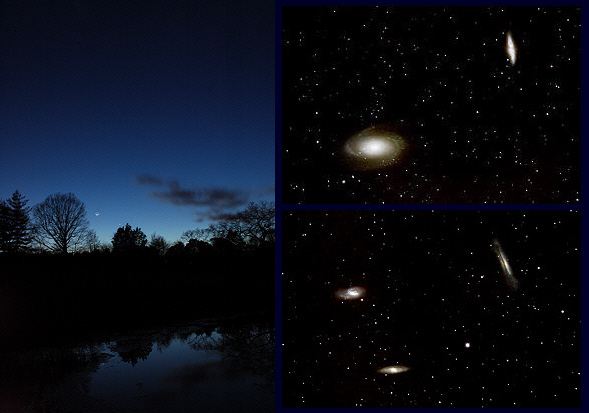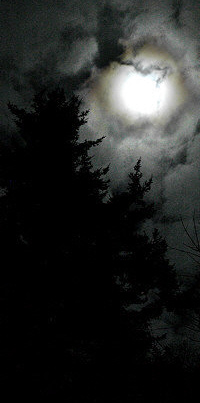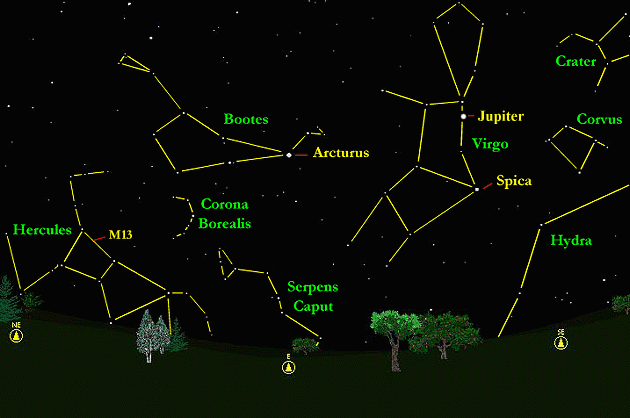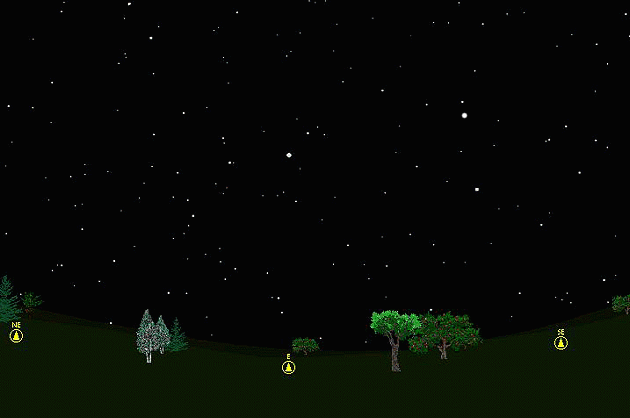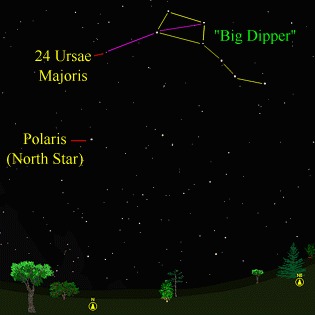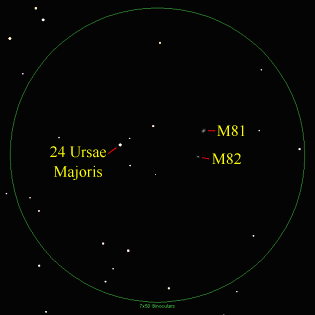The purpose of this feature is to give scout leaders, educators and naturalists an idea of some of the natural events coming up each month. We will try to cover a variety of natural events ranging from sky events to calling periods of amphibians, bird and mammal watching tips, prominent wildflowers and anything else that comes to mind. We will also note prominent constellations appearing over the eastern horizon at mid-evening each month for our area for those who would like to learn the constellations. If you have suggestions for other types of natural information you would like to see added to this calendar, let us know! Note: You can click on the hyperlinks to learn more about some of the featured items. To return to the Calendar, hit the "back" button on your browser, NOT the "back" button on the web page. All charts are downloadable in a "printer friendly" mode, with black stars on a white background. To download them this way, just left click on the chart. Notes and Images From March 2005
Clockwise from left: The Moon and Mercury set over our pond, March 11th. Mercury is to the right and below the moon, just above the treetops. Nikon D70 camera with tripod. Galaxies M81 (left) & M82 in Ursa Major, March 3rd. Charts for finding these galaxies are below. Galaxies M65, M66 and NGC 6228 in Leo, March 20th. Nikon D70 Camera, 8" f/4 Schmidt-Newtonian telescope.
March brought some beautiful astronomical vistas, some of which are shown above and at right. Southern Leopard Frogs called from our pond even while I was standing at the edge imaging Mercury and the Moon. Southeastern Chorus Frogs have been calling day and night on warm days. A Great Horned Owl with two young in the nest was observed on March 15th. On a trip to the Blue Ridge Mountains for our bird and herp inventory we found masses of Wood Frog eggs in many puddles in and along the jeep roads, and the night air was filled with the sound of Spring Peepers. We came upon an American Woodcock calling from the middle of a dirt road during our night bird survey on March 20th. We heard the drumming of Ruffed Grouse the following morning, and as we worked our stream transects for salamanders we enjoyed the beautiful songs of two Winter Wrens.
Sky Events for April 2005: The Lyrid Meteor Shower: This year's Lyrid meteor shower peaks in the early morning hours of April 22nd. This year a waxing gibbous moon will tend to brighten the sky and hamper observations. Look northeast near the bright star Vega, in the constellation Lyra. Vega rises about 9:15 pm CDT on the 21st. Evening Sky: Brilliant Jupiter, in Virgo, is already about 25 degrees above the eastern horizon at dusk at mid-month. It is about 12 degrees above the bright star Spica. Saturn continues to shine high in the west in Gemini. Around the end of April, see if you can spot Venus just above the west-northwest horizon 30 minutes after sunset. Morning Sky: Mars rises around 3:30am CDT at mid-month in Capricornus. The red planet continues to grow larger and brighter as it draws nearer to the earth. Mercury has a poor apparition in April, rising only about an hour before the sun on April 26th, when it reaches greatest elongation from the sun. All times noted in the Sky Events are for Franklin, Tennessee and are Central Daylight Time. These times should be pretty close anywhere in the mid-state area. Constellations: The views below show the sky looking east at 9:00pm CDT on April 20th. The first view shows the sky with the constellation outlined and names depicted. Star and planet names are in yellow. Constellation names are in green. The second view shows the same scene without labels. New constellations this month in the eastern sky are Serpens Caput, the Serpent (Head), and Hercules, the Strongman. As spring progresses and Hercules rises higher in the sky, look for the globular cluster Messier 13 (M13), which appears like a small fuzzy patch of light about 1/3 of the distance between Eta and Zeta Hercules (see illustration below). A cluster of stars about 21,000 light years away, M13 can be made out with the naked eye in a dark country sky when the constellation is high in the sky. Binoculars help pick it out.
Far Away: If you are a fan of galaxies, spotting them in binoculars is a little like spotting the faint running lights of a majestic ship far out at sea. The galaxies Messier 81 and Messier 82 (see image at top of page) were discovered by Johann Bode in December of 1774. The challenge, with binoculars, is just to find them at all. You will need a dark moonless sky and you will need to be away from city lights. Even then, they will appear only as very small and faint smudges of light. If you find them you will be basking in ancient light. The photons that tickle your retina are ending a journey that took them 12 million years to complete. Even with a small telescope it's possible to see the cigar shape of M82, and under dark skies you can see the largest dark rift that seems to cut the galaxy in two. To find the galaxies, face due north in the early evening and find the "Big Dipper" (part of Ursa Major). As shown below, draw an imaginary line across the bowl of the dipper and extend the line as shown to find the star 24 Ursae Majoris. You may need binoculars to see this star. Then look at the binocular view to the right. The green circle shows the field of view of a typical pair of binoculars. Look for the pattern of the four stars close to 24 Ursae Majoris and use them to guide you to the two galaxies. When you know where they are, use averted vision and look slightly to one side of them. This will result in the faint light from the galaxies falling on the more light sensitive areas of your retina. If you don't use binoculars on a regular basis, you may need to practice looking at some of the bright stars of the Big Dipper before trying to put them on 24 Ursae Majoris. It helps if you never take your eyes off your target as you are raising the binoculars to your eyes. You will know you are in the right place if you see the pattern of stars shown below around 24 Ursae Majoris. M81 is over twice as bright as M82, so you will probably spot it first. In a fairly dark sky, I spot M81 with both my Zeiss 8x30 binoculars and my Canon 10x30 image-stabilized binoculars. I'm only able to see M82 with the 10x30's, but with these binoculars I could actually see the orientation of M82 with averted vision. To evaluate binoculars for astronomical use, I prefer Alan Adler's "Astro Index" method (Sky and Telescope, September 2002). To compare binoculars, you multiply the power times the square root of the aperture. With this method, my 8x30's would rate 43.8 and my 10x30's would rate 54.7.
On Learning the Constellations: We advise learning a few constellations each month, and then following them through the seasons. Once you associate a particular constellation coming over the eastern horizon at a certain time of year, you may start thinking about it like an old friend, looking forward to its arrival each season. The stars in the evening scene above, for instance, will always be in the same place relative to the horizon at the same time and date each April. Of course, the planets do move slowly through the constellations, but with practice you will learn to identify them from their appearance. In particular, learn the brightest stars (Like Arcturus and Spica in the above scene looking east), for they will guide you to the fainter stars. Once you can locate the more prominent constellations, you can "branch out" to other constellations around them. It may take you a little while to get a sense of scale, to translate what you see on the computer screen or what you see on the page of a book to what you see in the sky. Look for patterns, like the stars that make up the constellation Corvus. The earth's rotation causes the constellations to appear to move across the sky just as the sun and the moon appear to do. If you go outside earlier than the time shown on the charts, the constellations will be lower to the eastern horizon. If you observe later, they will have climbed higher. As each season progresses, the earth's motion around the sun causes the constellations to appear a little farther towards the west each night for any given time of night. If you want to see where the constellations in the above figures will be on May 20th at 9:00pm CST, you can stay up till 11:00pm CST on the April 20th and get a preview. The westward motion of the constellations is equivalent to two hours per month. A good book to learn the constellations is H. A. Rey's classic, The Stars, A New Way to See Them. Rey's depictions of the constellations and witty commentary are terrific. A good general reference book on astronomy is the Peterson Field Guide, A Field Guide to the Stars and Planets, by Pasachoff. The book retails for around $14.00. A good beginners software program for learning the night sky is the Starry Night Beginner program. Visit the Starry Night web site at www.starrynight.com The program retails for around $30.00 and contains a wealth of information.
Amphibians:
Many frogs and toads are already calling (see the March 2005 Natural Calendar). We usually hear our first American Bullfrogs, Green Frogs, Northern Cricket Frogs, Southern Cricket Frogs, Pickerel Frogs and Fowler's Toads in April, although many of these species can be seen before then. We hear Cope's Gray Treefrog sporadically in March and April on warm days. These early calls of Gray Treefrogs sound raspier than the normal trill, as if the frog needed to clear its throat. Many of the frogs and toads that began calling earlier in the year, like Spring Peepers, American Toads and Southeastern Chorus Frogs, continue to call.
Birds: The spring migration builds very quickly in April. The neo-tropical migrants are too numerous to list here, but now is the time to get out in the early morning with a pair of binoculars and welcome the new arrivals for the day. Listen at dusk for young Great Horned Owls and Young Barred Owls, doing their raspy "begging" calls.
Recommended: Bird Finding in Tennessee, Michael Lee Bierly. A classic guide to finding birds in Tennessee. The Sibley Guide to Birds, David Allen Sibley The Sibley Guide to Birds of Eastern North America, David Allen Sibley This new Sibley Guide covers only eastern North America, is quite compact, and is less expensive than the larger Sibley. An inexpensive guide for beginners is the Golden Guide for Birds.
Wildflowers: Some of our favorite Spring wildflower walks are: The south ridge at the Owl's Hill Nature Center in Brentwood, Tennessee. The Edwin Warner paved loop at the Warner Parks in Nashville or just about any trail in Warner Parks. The greenway at Ashland City, Tennessee. The Angel Falls trail along the Cumberland River at the Big South Fork Recreational Area, near Jamestown, Tennessee.
Archives (Remember to use the back button on your browser, NOT the back button on the web page!)
Natural Calendar
February 2005
Natural Calendar
December 2004
Natural Calendar
November 2004
Natural Calendar
September 2004
Natural Calendar
February 2004
Natural Calendar
December 2003
Natural Calendar
November 2003
Natural Calendar
September 2003
Natural Calendar
February 2003
Natural Calendar
December 2002 Natural Calendar November 2002
Nature Notes Archives: Nature Notes was a page we published in 2001 and 2002 containing our observations about everything from the northern lights display of November 2001 to frog and salamander egg masses. Night scenes prepared with Starry Night Pro software All images © 2005 Leaps
|
